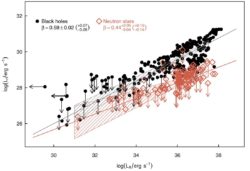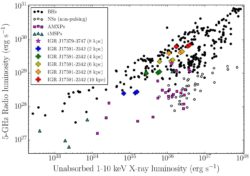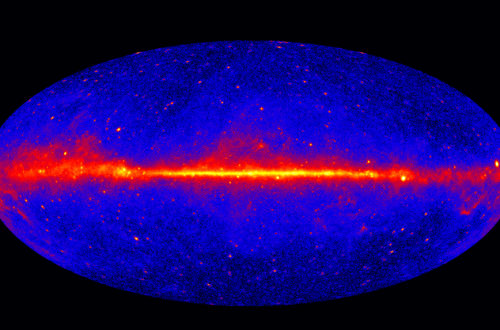Hi all,
Firstly, I hope you all had a great holiday period!
Over the Christmas break, I had a paper published in ApJ letters (links at the bottom of the page) that I thought I might summarise here. This paper was focused on the radio emission from a newly discovered X-ray transient called IGR J17591-2342. In this post, I want go through events in chronological order, which should show our thinking and highlight the reason for our paper.
However, before I get too carried away, I first need to introduce something called the radio/X-ray correlation for accreting stellar-mass compact objects. There is a well-studied non-linear relationship between the radio and X-ray luminosities during the rise and decay phases of outbursts from X-ray binaries. This is observed for both black hole and neutron star systems. Plotting up the radio and X-ray luminosity from observations from each of these type of systems (Fig 1) shows that while individual systems can show varying correlation indices and normalisations, and not all sources follow similar, or even well-defined tracks (but some do), black hole X-ray binaries are generally significantly more radio bright than their neutron star counterparts (see Gallo et al. 2018, for a really nice summary).

Now back to our source (IGR J17591-2342)… remember this is all chronological, so we are starting right from the start.
In 2018 August a new X-ray transient (subsequently named IGR J17591-2342) was discovered during the early stages of its outburst. This source was discovered using the INTEGRAL X-ray telescope, during monitoring of the Galactic centre. At first, we (astronomers monitoring this object) didn’t know what this source was, whether it was an accreting black hole or neutron star. However, following the initial X-ray detection and rise of the outburst, we observed and detected this source in the radio band with the Australia Telescope Compact Array (ATCA). The radio emission we detected was nice and bright. Assuming a distance, we can then calculate the radio and X-ray luminosity (where the X-rays were taken from quasi-simultaneous Swift-XRT observations) and place this source on the radio/X-ray correlation, which can help to identify the nature of the source (Fig 2).

Because of the direction to the source, we thought that the source was likely near to the Galactic centre (just following simple population numbers), so something in the 6 to 10 kpc range. Taking a look at Fig. 2, this seems to suggest that the source was an accreting black hole, and possibly even a radio-bright one. We reported as such in our ATel (Astronomer’s Telegram) of this source. At this point everything looked normal. We were seeing an outburst from an actively accreting black hole X-ray binary.
However, the very next day, a team monitoring this source with the NuSTAR and NICER X-ray telescopes reported X-ray pulsations from this source…. such pulsations are periodic variations in the X-ray intensity that are thought to be caused by gas being channeled out of the accretion disk and onto the magnetic poles of the rotating neutron star, which gives rise to X-ray pulsations at the spin frequency of the neutron star… This is something that a neutron star can do, but a black hole wouldn’t.
Therefore, the detection of X-ray pulsations firmly places this source as an accreting neutron star, in particular, and accreting millisecond X-ray pulsar (AMXP; see Patruno & Watts 2013 for a very nice and comprehensive summary of AMXPs).
So that means that our source is either very nearby, or is just very radio bright (much brighter than the other accreting neutron starts we have previously detected).
Taking a look at the X-ray emission shows that the X-ray emission was strongly absorbed. This usually indicated that the emission has to travel through a lot of ‘stuff’ as it travels from the origin to our detectors. Given the location in the sky, where we don’t expect a lot of absorption until we get closer to the Galactic centre (Green et al. 2018), we think that this source is most likely close to the centre of our Galaxy, making it further away (probably >6 kpc), and therefore, much more radio bright than we’d usually expect. We should note, however, it is possible that maybe the source has a lot of local absorption, which we couldn’t completely rule out, but find it unlikely.
Such a radio-bright neutron star creates a few questions and a few problems. One of those questions is why is this system so radio bright? Maybe it is the spin, or magnetic field, which can possibly alter the jet power? But this source doesn’t seem to have an extremely high spin, or a high magnetic field, so maybe it is a combination of the two, plus a bunch of other factors? Maybe the inclination is important here and the source is strongly beamed? At the moment, we don’t really know why it is so bright. Hopefully, further studies will help to reveal why.
This result also calls into question the way we use the radio/X-ray luminosity to classify sources as either an accreting stellar-mass black hole or neutron star. It shows us that while this method is a decent approximate indicator, we do have to be careful if we are just using this method.



